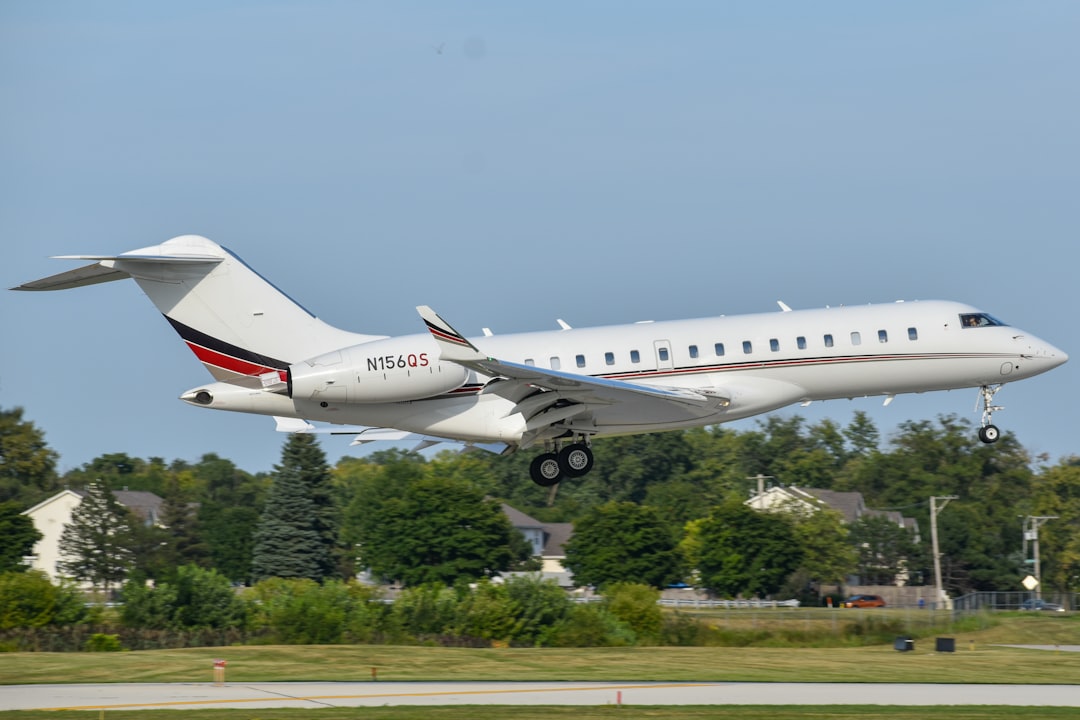What All Those Lines on Runways and Ramps Really Mean
Published on June 23, 2025 • 5 min read

Those white stripes on runways and yellow lines crisscrossing the ramp appear everywhere in aviation. For FBO managers juggling aircraft movements daily, understanding these markings is operational knowledge that prevents expensive mistakes.
With 1,115 runway incursions recorded in just 12 months (ending May 2024), getting these markings right has never been more critical. Understanding this painted language of airports could save your operation thousands of dollars and prevent serious accidents.
The Color Code That Saves Lives
Remember this fundamental rule: White is for runways, yellow is for everything else. This safety system, specified in FAA Part 139 regulations, functions even in low visibility conditions.
WHITE MARKINGS
- All runway markings
- Landing areas
- Areas under tower control
YELLOW MARKINGS
- Taxiway markings
- Ramp/apron areas
- Holding positions
- Closed/hazardous areas
Runway Markings: The Pilot's Visual GPS
Centerline Markings
That continuous white stripe down the middle? It's 36 inches wide and serves as the pilot's guide during the most critical phases of flight. Think of it as the runway's highway lane marker—keeping aircraft tracking straight during takeoff and landing.
Threshold Markings: Runway Width at a Glance
Those white stripes at the runway's beginning aren't just decorative—they're a coded message about runway width:
4 stripes = 60 feet wide
6 stripes = 75 feet wide
8 stripes = 100 feet wide
12 stripes = 150 feet wide
16 stripes = 200 feet wide
For FBO operations, this matters when positioning ground equipment or planning aircraft parking—you need to know exactly how much runway real estate you're working with.
Touchdown Zone: Distance References for Ground Operations
Those thin white bars in the first 3,000 feet of runway? They're touchdown zone markings, coded to show distance in 500-foot increments. After the thick aiming point stripes at 1,000 feet, you'll see:
- 1,500 & 2,000 feet: Two bars on each side
- 2,500 & 3,000 feet: One bar on each side
These aren't just pilot aids—they're critical for ground crews positioning equipment and calculating runway occupancy times.

Taxiway and Ramp Markings: Your Yellow Brick Road
Centerline Markings
Those continuous yellow stripes (6 inches wide) guide aircraft along taxiways and through ramp areas. What many ground crews don't realize is that following these lines isn't just about convenience—it's about keeping wingtips clear of obstacles and other aircraft.
Edge Markings: The Boundaries That Matter
Broken double yellow lines mark taxiway edges—each line is 6 inches wide with 15-foot segments and 25-foot gaps. These aren't suggestions; they define the safe movement area for aircraft.
The Critical Movement Area Boundary
Yellow boundary markings separate areas under air traffic control from non-movement areas like your ramp. Cross this line without clearance, and you've just committed a runway incursion—even if you're nowhere near the actual runway.
The Million-Dollar Mistakes These Markings Prevent
In February 2023, a Southwest 737 and FedEx 767 nearly collided at Austin-Bergstrom International Airport. The culprit? Poor visibility and confusion about surface markings during taxi operations. The planes came within 100 feet of each other.
This incident led to new FAA mandates requiring surface detection equipment at qualifying airports by end of 2025. But technology can't replace understanding the basic visual language painted on the ground.
The Real Cost of Marking Misunderstandings
For FBOs, marking confusion translates to direct operational costs:
Insurance Claims: Ground damage incidents average $35,000-$150,000 per occurrence. A single wingtip strike from incorrect positioning can cost more than most FBOs' annual profit margin. Understanding 3D aircraft stacking helps prevent positioning errors.
Operational Delays: When ground crews misinterpret markings, aircraft positioning takes longer, creating cascading delays that frustrate customers and reduce throughput during peak hours. Optimize ramp revenue with better procedures.
Training Costs: Incident-related retraining can consume 40+ hours per employee, plus potential FAA scrutiny and compliance audits. Address staffing challenges with systematic training.
Case Study: The $127,000 Yellow Line
A regional FBO learned this lesson the hard way. During a busy Friday afternoon, a ground crew member positioned a Citation CJ3 outside the yellow taxiway edge lines while marshaling it to the fuel island. The pilot, following the marshallers' signals, clipped a stationary King Air's wingtip.
The result:
- $127,000 in combined aircraft damage
- 3 days of aircraft downtime for each plane
- 2 very unhappy customers who switched to competitors
- 16 hours of incident investigation and reporting
- $45,000 insurance deductible
- Mandatory retraining for all ground crew
The root cause was simple: the crew member didn't understand that yellow edge markings define the safe movement envelope—not suggestions for where aircraft "should" be positioned. A $200 training investment could have prevented a $127,000 lesson.
By the Numbers: Why Markings Matter
- 40% of runway incursion reports come from GA pilots
- 74% decrease in serious runway incursions in 2024's first seven months
- Surface detection systems becoming mandatory at major airports
- $10+ billion in annual ground damage costs industry-wide
- Average FBO ground damage claim: $85,000
Hot Spots: Where Extra Attention Pays Off
Some airports mark "hot spots"—areas with history of incidents or high collision risk. These appear as circles or ellipses on airport diagrams, designated as "HS" followed by a number.
For FBO operations, knowing these hot spots means planning aircraft movements to avoid congestion during peak times and ensuring ground crews maintain extra vigilance in these areas.
When Weather Makes Markings Disappear
Winter operations present unique challenges that can turn routine operations into hazardous situations. When snow starts falling and visibility drops, even the most experienced ground crews face new risks.
Snow Coverage: When Markings Vanish
Fresh snow covers markings completely, making taxiway edges invisible. Experienced FBOs maintain detailed ramp diagrams with measurements and use GPS-guided equipment positioning during snow events.
Low Visibility Operations
In fog or heavy rain, even fresh markings become difficult to distinguish. During these conditions:
- Reduce aircraft movement speed by 50%
- Assign dedicated spotters for all aircraft positioning
- Use additional lighting and reflective cones to mark critical boundaries
- Implement enhanced radio communication protocols
The Reality of Marking Maintenance
Paint fades, especially in high-traffic areas. Yellow taxiway markings typically need refreshing every 2-3 years, while white runway markings last 3-5 years. Budget $15,000-$25,000 annually for marking maintenance at a typical FBO facility.
Building a Marking-Smart Ground Crew
The 30-Day Training Protocol
Based on successful FBO programs nationwide, this training approach has proven effective:
Week 1: Classroom fundamentals
- Color coding system (white vs. yellow)
- Runway width identification using threshold markings
- Critical movement area boundaries
Week 2: Field training with experienced crew
- Walking the entire ramp area identifying all markings
- Practice aircraft positioning using touchdown zone references
- Emergency procedures when markings are obscured
Week 3: Scenario-based training
- Low visibility positioning drills
- Winter operations procedures
- Communication protocols during complex aircraft movements
Week 4: Assessment and certification
- Written test on marking meanings and operational procedures
- Practical demonstration of safe aircraft positioning
- Emergency response scenarios
Ongoing Training Requirements
- Monthly refresher sessions (15 minutes during shift meetings)
- Annual recertification with updated procedures
- Incident review sessions when marking-related issues occur
- New hire buddy system pairing inexperienced crew with veterans

Your Action Plan: Making Markings Work for You
Understanding these markings isn't academic—it's practical knowledge that impacts daily operations. Take action on these priorities:
Immediate Actions (This Week)
- Conduct a ramp walk with your operations team to identify all markings and their current condition
- Create a marking reference guide with photos of your specific ramp layout and critical boundaries
- Review insurance claims from the past 2 years to identify marking-related incidents
- Schedule marking maintenance for any faded or damaged lines
30-Day Implementation Plan
- Implement the ground crew training protocol outlined above
- Establish winter operations procedures for when markings are obscured
- Create aircraft positioning templates using threshold markings for common aircraft types
- Develop communication protocols for movement area boundary crossings
Ongoing Operations
- Monthly marking inspections during safety meetings
- Quarterly training refreshers incorporating any new incidents or procedures
- Annual budget planning for marking maintenance and training costs
- Incident reporting system to track marking-related operational issues
ROI Measurement
Track these metrics to measure the business impact of improved marking awareness:
- Ground damage incidents per month
- Aircraft positioning time (should decrease with better training)
- Customer complaints about delays
- Insurance premium changes
- Training hours required for new hires
Those painted lines you see every day aren't just markings—they're a safety system that prevents the kind of incidents that make headlines for all the wrong reasons. When properly understood and respected, they become operational tools that can significantly improve your bottom line.
Want to optimize your hangar operations with the same precision these markings bring to runway safety? Our hangar management software applies the same systematic approach to aircraft positioning and space utilization that keeps airports safe.


